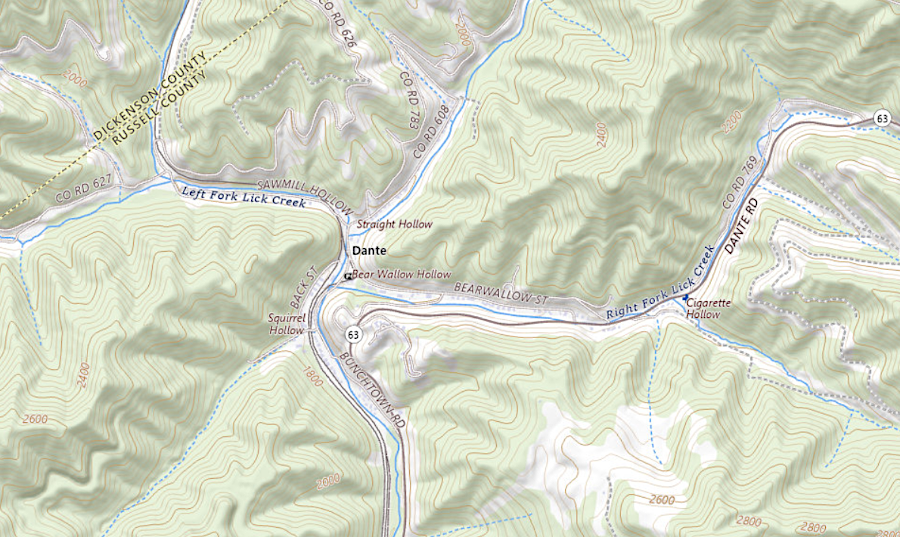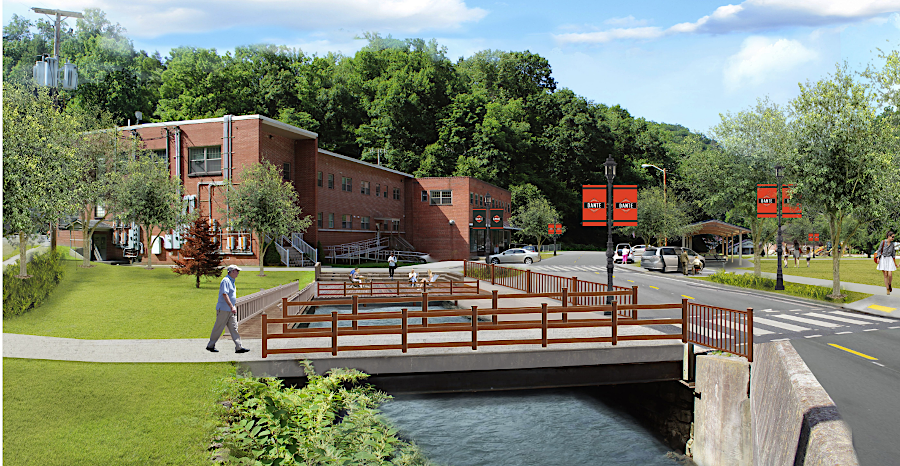
Dante was first called Turkeyfoot due to the shape of three branches of Lick Creek
Source: ESRI, ArcGIS Online

Dante was first called Turkeyfoot due to the shape of three branches of Lick Creek
Source: ESRI, ArcGIS Online
When the area around Dante was first settled in the 1800's, the community was called Turkeyfoot. Three branches of Lick Creek converged to create topography that resembled the toes of a turkey's foot.
Stilson Hutchins purchased the mineral rights to the coal and founded a company town. He named after his business partner, William Joseph Dante, in the Dawson Coal and Coke Company. The community is pronounced "Daint," and rhymes with "paint." Hutchins was also a founder of the Carolina, Clinchfield & Ohio Railroad.
Hutchins was able to purchase the mineral rights at low cost ($18/acre) because there was no easy way to ship the coal to market. He solved that problem by building the Lick Creek and Lake Erie Railroad to the Norfolk and Western Railway at St. Paul. That track was located on a seven mile stretch of the uncompleted Charleston, Cincinnati & Chicago Railroad. Spur lines were built into the coal fields. Modern Bunch Town Road is on the bed of one such line.
George L. Carter acquired the rights to the Charleston, Cincinnati & Chicago Railroad and multiple coal companies in Southwest Virginia. He consolidated them into the Clinchfield Coal Company and built the Carolina, Clinchfield & Ohio Railroad connecting coal mines in Southwest Virginia to Elkhorn, Kentucky. It became the Clinchfield Railroad in 1924.
Clinchfield Coal Company acquired Dante in 1906 and established its headquarters there in 1912. All housing was constructed by the company and rented to the workers. To accommodate the diverse religious perspectives of the miners, the company constructed Baptist, Presbyterian, Episcopalian, and Catholic churches.
The community was never incorporated as a town and relied upon the Clinchfield Coal Company for services such as drinking water, electricity, fire protection, jail, telephone service, schools, hospitals and churches. A frame building for the combined freight and passenger Clinchfield Railroad depot was constructed in 1909, then replaced in 1931 with the current brick structure. As was traditional in segregated Virginia, separate waiting rooms were built for black and white passengers.
The steam heat plant, now the oldest remaining structure, was constructed in 1910 by Italian immigrants. It serviced the commercial buildings, and provided heat in the winter to the homes of managerial and administrative employees.1
To find workers to dig and ship the coal, the company recruited immigrants with different nationalities as well as black sharecroppers. Neighborhoods in Dante were segregated by both ethnic origin, race, and wealth. The Hungarian immigrants concentrated in upper Straight Hollow and Greeks lived even further upstream. Black miners lived in a different section of Straight Hollow and in Sawmill Hollow. All the miners lived down low in the stream valleys near the creek. The managers lived higher up on the hillsides, and originally only the houses on Roanoke Hill had indoor plumbing and heat.
Even the two cemeteries were distinct. One was reserved for African Americans and European immigrants, the other for native-born white Americans.
The Clinchield Coal Company continued to mine and sell enough coal during the Great Depression to kept Dante operating, though at a reduced scale. The community contained 516 houses and 59 other buildings in 1939, all constructed by the company:2
Source: The Nature Conservancy, Dante
The Pittston Coal Company acquired the Clinchfield Coal Company in 1944. After World war II, coal production dropped and the population quickly declined. Many black and ethnic miners, with fewer options for local jobs, left Dante.
In 1947, after Federal regulations no longer allowed the company to deduct rent from paychecks, Pittston Coal Company sold the houses. Residents were given the first opportunity to purchase the structure where they were living.
The Clinchfield Inn, across the street from the company store, was demolished in 1956. The Dante Central School burned in 1958. The coal mines closed in 1959. The headquarters of the Clinchfield Coal Company moved to Lebanon in 1972. The hospital closed two years later. The company store ("Store B") at the center of town was torn down in 1958.
"Lingerlong," home of the general superintendent for Clinchfield Coal Corporation, has survived. The bank closed in the Great Depression on March 27, 1931. The 1919 building became the Beer Garden restaurant and is now the Coal and Railroad Heritage Museum. Alpha Natural Resources donated it to a non-profit group, Dante Lives On, in 2003.3
In 2020, there were 572 people living in the Dante community at the base of Hazel Mountain.4
Efforts to revitalize Dante are led by the Dante Community Association, which organized in 2016. It recruited the Virginia Tech Community Design Assistance Center, which in 2017 conducted a Community Design Charrette and completed Dante Downtown Master Plans. As in Colonial Williamsburg, the lack of economic activity after boom times has left many original structures in the downtown. The Dante Downtown Historic District was added to the National Register of Historic Places in 2023.5

daylighting Lick Creek to create a community amenity is part of the plan to revitalize Dante
Source: Dante Community Association, Dante: Conceptual Downtown Master Plan and Park Design

the core of Dante was designated as a historic district in 2023
Source: Virginia Department of Historic Resources, Dante Downtown Historic District
Source: Real Appalachia, Tucked Away in the Lonesome Hills of Appalachia: The Once Mighty Coal Town of Dante, Virginia